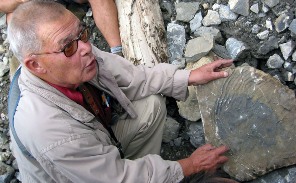
Distinguished palaeontologist, pioneer of trace fossil studies and philosopher of form and function
Adolph Seilacher (picture: Seilacher demonstrating Spiroraphe. Taken by Anthony Martin, July 2003), who died in late April in his 89th year, was one of the most distinguished palaeontologists of his generation, and an Honorary Fellow of the Geological Society. He served as a soldier briefly in World War Two before work at the University of Tübingen led to a PhD under the Professor of Palaeontology, Otto Schindewolf, which was focused on trace fossils, a highly original topic at the time. After short spells at the Universities of Frankfurt and Baghdad he took a junior chair at Göttingen before returning to Tübingen in 1964 to succeed Schindewolf as Professor of Palaeontology. After 1987 he held an adjunct Professorship at Yale University and subsequently divided his time between the two institutions, before retiring to Tübingen in his early 80s.
Seilacher’s numerous publications cover a range of topics of which those on trace fossils are probably the best known, especially, for geologists their bathymetric significance. He established the concept of ichnofacies, distinctive assemblages of trace fossils controlled largely by depth of sea. This was later expanded to include the influence of substrate, oxygen, salinity and so on. In addition he analysed many trace fossils in terms of behaviour they represent, leading to such work as a computer simulation of trace fossil morphology with David Raup in 1969. Much of this work is summarised, together with new material, in his late book Trace Fossil Analysis published by Springer in 2007.
In 1970 he announced his programme of Constructional Morphology in which he stressed the importance of three factors determining the form of organisms: ecologic- adaptive aspects history and constructional aspects. The latter two factors are important sources of biological constraints. They acknowledge that both history and constructional principles place limits on what can be achieval in evolution, in at least the short term. Such a view was influential on later workers such as Stephen Jay Gould and Richard Lewontin, in their well known paper on “spandrels” that critised panadaptationist concepts of evolution and form. Seilacher’s interest in pattern formation led him to espouse self-organisation models for the origin of form, the most famous of which are “pneu” structures. These are fluid –filled structures under tension whose form is broadly determined by the need to distribute tension across the surface. He may thus be considered a structuralist.
Seilacher also published important papers on fossil Lagerstätten and indeed much of his work has been concerned with preservation and taphonomy in general. His most controversial contributions arise from his research on Ediacaran assemblages, which he suggested, based on their constructional morphology, to be pneu structures completely unrelated to modern metazoans, and termed Vendobionts, He went so far as to relate many of these taxa to giant rhizopodal protists. While these views have not met with widespread acceptance, they exemplitfy his profound imaginativeness.
Among the many honours he received, one should single out the top medals of the Palaeontological Association and Paleontological Society and especially the Crafoord Prize in Sweden (1992), awarded annually to scientists in fields not covered by the Nobel Prizes, but of comparable prestige. Seilacher is the only palaeontologist to have been awarded this. Anyone privileged to have known him well would have recognised in him a striking combination of sharp observation and keen insight combined with rich imagination and excellent draughtsmanship. What was especially impressive is that he retained a keen intellectually curiously into his eighties. Despite his advanced age at death there is bound to be a feeling of especial loss that someone of such formidable talents has finally left us.
Tony Hallam